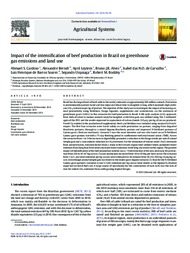Impact of the intensification of beef production in Brazil on grenhouse gas emissions and land use.
Impact of the intensification of beef production in Brazil on grenhouse gas emissions and land use.
Author(s): CARDOSO, A. S.; BERNDT, A.; LEYTEM, A.; ALVES, B. J. R.; CARVALHO, I. das N. O. de; SOARES, L. H. de B.; URQUIAGA, S.; BODDEY, R. M.
Summary: Brazil has the largest herd of beef cattle in the world, estimated at approximately 200 million animals. Production is predominantly pasture-based and low input and hence time to slaughter is long, which promotes high methane (CH4) emissions per kg of product. The objective of this study was to investigate the impact of increasing animal productivity using fertilizers, forage legumes, supplements and concentrates, on the emissions of greenhouse gases (GHGs) in five scenarios for beef production in Brazil. A life cycle analysis (LCA) approach, from birth of calves to mature animals ready for slaughter at the farm gate, was utilized using Tier 2 methodologies of the IPCC and the results expressed in equivalents of carbon dioxide (CO2eq) per kg of carcass produced. Fossil CO2 emitted in the production of supplements, feeds and fertilizers was included using standard LCA techniques. The first four scenarios were based solely on cattle production on pasture, ranging from degraded Brachiaria pastures, through to a mixed legume/Brachiaria pasture and improved N-fertilized pastures of Guinea grass (Panicum maximum). Scenario 5 was the most intensive and was also based on an N-fertilized Guinea grass pasture, but with a 75-day finishing period in confinement with total mixed ration (TMR). Across the scenarios from 1 to 5 the increase in digestibility promoted a reduction in the forage intake per unit of animal weight gain and a concomitant reduction in CH4 emissions. For the estimation of nitrous oxide (N2O) emissions from animal excreta, emission factors from a study in the Cerrado region were utilized which postulated lower emission from dung than from urine and much lower emissions in the long dry season in this region. The greatest impact of intensification of the beef production systems was a 7-fold reduction of the area necessary for production from 320 to 45 m2/kg carcass. Carcass production increased from 43 to 65 Mg per herd across the scenarios from 1 to 5, and total emissions per kg carcass were estimated to be reduced from 58.3 to 29.4 kg CO2eq/kg carcass. Even though animal weight gain was lower in the mixed grass-legume scenario (3) than for the N-fertilized Guinea grass pastures (scenarios 4 and 5) GHG emissions per kg carcass were similar as the legume N2 fixation input had no fossil-fuel cost. A large source of uncertainty for the construction of such LCAs was the lack of data for enteric CH4 emissions from cattle grazing tropical forages.
Publication year: 2016
Types of publication: Journal article
Observation
Some of Embrapa's publications are published as ePub files. To read them, use or download one of the following free software options to your computer or mobile device. Android: Google Play Books; IOS: iBooks; Windows and Linux: Calibre.
Access other publications
Access the Agricultural Research Database (BDPA) to consult Embrapa's full library collection and records.
Visit Embrapa Bookstore to purchase books and other publications sold by Embrapa.

